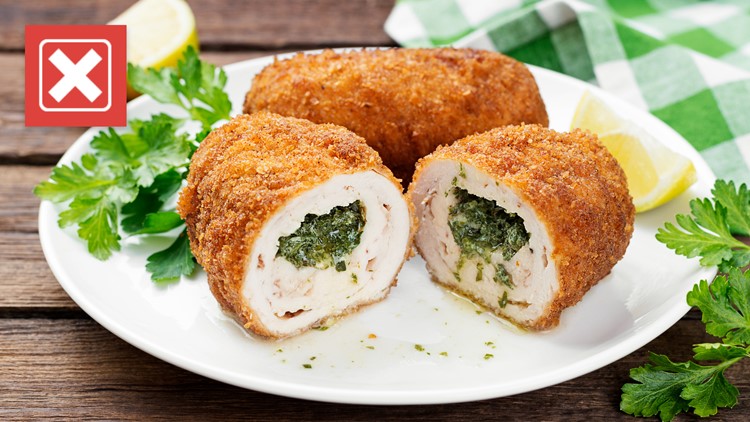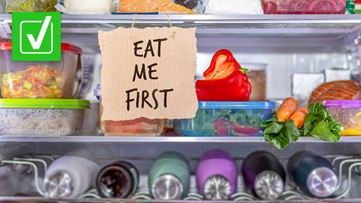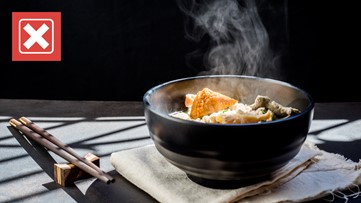The U.S. Department of Agriculture proposed limiting the amount of salmonella bacteria in some chicken products on April 25, according to news reports. Salmonella is a bacteria often contracted from certain raw or undercooked foods. Salmonella infections can cause a flu-like illness that in rare cases can be serious.
Many people were confused by this news, wondering if the salmonella limit in chicken wasn’t already zero, why the new proposal doesn’t set the limit at zero.
THE QUESTION
Does the USDA require raw chicken products to be salmonella-free?
THE SOURCES
THE ANSWER
No, the USDA doesn’t require raw chicken products to be salmonella-free.
WHAT WE FOUND
On April 25, the U.S. Department of Agriculture (USDA) announced a proposal to begin declaring salmonella an “adulterant” in “breaded stuffed raw chicken products” if levels went above a very low quantity of salmonella.
Adulterants are contaminants in foods that can harm people’s health. Adulterated products cannot be legally sold in the United States, the Ohio State University Center for Foodborne Illness Research and Prevention says.
“Breaded stuffed raw chicken products” refers to products like pre-breaded chicken breasts stuffed with vegetables, fruits, cheese or other meats that people are supposed to pop into the oven to heat up before eating. Chicken cordon bleu and chicken kiev are examples of such products.
Currently, the USDA does not ban raw stuffed chicken products, or other raw chicken products, based on salmonella contamination.
A series of court decisions over the decades have ruled in favor of the USDA not regulating foodborne pathogens, such as salmonella and E. coli, in most raw beef and poultry products, the National Agricultural Law Center says.
The USDA has previously decided against banning salmonella and E. coli because it argued salmonella and other foodborne pathogens were best handled at the consumer level during food preparation — basically, the USDA said that properly cooking chicken is the best way to prevent salmonella contamination.
However, the USDA’s one exception is in ground beef, the National Agricultural Law Center says. Many consumers believe ground beef to be properly cooked at medium, medium-rare or rare, but E. coli isn’t reliably killed unless the beef is cooked to at least medium-well. Because of that, E. coli is considered an adulterant in ground beef.
The USDA is applying similar logic to the current situation with raw chicken that is breaded and stuffed.
“Data from outbreaks and [USDA’s] consumer research show that some people may not realize these products contain raw chicken because the outside may appear browned and cooked, which leads them to believe that the product is safe to eat as is or not cook the product to a safe internal temperature,” the USDA said in their April 25 announcement.
The National Chicken Council (NCC), which represents the poultry industry, is against this proposal. It argues that the USDA has never “rendered raw poultry adulterated” based on the “mere presence” of salmonella. The NCC says the USDA can use different regulatory measures to ensure the safety of these products.
The NCC says it has petitioned the USDA twice for mandatory and stricter labels for breaded, stuffed raw chicken products. The mandatory labels would be designed to help consumers better understand the proper cooking procedures for these products.
For example, this Barber Foods product has the word “raw” on its front packaging four different times, as well as instructions not to microwave it. Consumers are advised to oven bake it only and cook it to an internal temperature of 165 degrees Fahrenheit.
The USDA says the salmonella bacteria causes approximately 1.35 million human infections every year; 23% of which are attributed to poultry consumption. It says that it has investigated 14 salmonella outbreaks and approximately 200 illnesses associated with breaded stuffed raw chicken products since 1998, the most recent of which was in 2021.
The NCC argues there has only been one such outbreak since 2015 — the aforementioned 2021 outbreak. It notes that the 2021 investigation found some consumers reportedly did not cook the stuffed chicken products in an oven as described on the product label, and instead reported using a microwave or air fryer to cook them.













